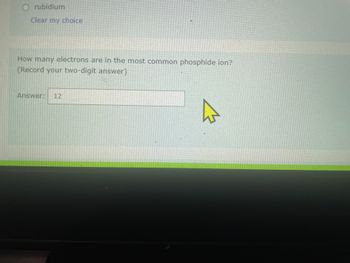
Chemistry
10th Edition
ISBN: 9781305957404
Author: Steven S. Zumdahl, Susan A. Zumdahl, Donald J. DeCoste
Publisher: Cengage Learning
expand_more
expand_more
format_list_bulleted
Question

Transcribed Image Text:Orubidium
Clear my choice
How many electrons are in the most common phosphide ion?
(Record your two-digit answer)
4
Answer:
Expert Solution
This question has been solved!
Explore an expertly crafted, step-by-step solution for a thorough understanding of key concepts.
Step by stepSolved in 2 steps

Knowledge Booster
Learn more about
Need a deep-dive on the concept behind this application? Look no further. Learn more about this topic, chemistry and related others by exploring similar questions and additional content below.Similar questions
- What is the percent of N in N2H4?arrow_forwardHelp solve plsarrow_forwarda. Rubidum chloride, RbCl, and sulfuric acid, H₂SO4 Rule 4: an exception to the rule for sulfates; RbCl(aq) + H₂SO4 (aq) → Rb₂SO4(s) + HCl(aq) Rule 4: an exception to the rule for sulfates; 2RbCl(aq) + H₂SO4 (aq) → Rb₂SO4 (8) + 2HCl(aq) Rule 4: an exception to the rule for sulfates; 2RbCl(aq) + H₂SO4 (aq) → Rb2SO4 (aq) + 2HCl(aq) O No precipitate: both Rb₂SO4 and HCI are soluble RbCl(aq) + H₂SO4 (aq) → no precipitate b. Potassium carbonate, K₂CO3, and barium chloride, BaCl₂ O Rule 6: Most carbonate salts are only slightly soluble; K₂CO3(aq) + BaCl₂ (aq) → BaCO3(s) + 2KCl(aq) O Rule 6: exeption to rule for carbonates; 2K₂CO3(aq) + BaCl₂ (aq) → BaCO3(s) + 2KCl(aq) O Rule 6: Most carbonate salts are only slightly soluble; K₂CO3(aq) + BaCl₂ (aq) → BaCO3(aq) + 2KCl(aq) O Rule 6: Most carbonate salts are only slightly soluble; K₂CO3(aq) + BaCl2 (aq) → BaCO3 (8) + KCl(aq) c. Sodium sulfate, Na2SO4, and barium nitrate, Ba(NO3)2 O Rule 4: an exception to the rule for sulfates; Na₂SO4 (aq) +…arrow_forward
- L Moving to another question will save this response. Question 7 What is the name of this compound? HO H OH 0 0 HN OH H A Moving to another question will save this response.arrow_forwardUsing puzzle pieces to model the 16 neutral compounds that may be formed by combining four different cations with each of four different anions.arrow_forwardPart A: Pairs of ions are attracted to each other to build an ionic ________ Your answer Part B: Pairs of ions are attracted to each other to build an ionic ________ Part C: What is the formula for Sodium Chloride? Part D: What is the ratio of Sodium ions to Chloride ions in Sodium Chloride? Your answerarrow_forward
- Answer quickly please for testarrow_forwardObserving Reactions and Writing Chemical Equations Name Date PRE-LAB ASSIGNMENT: 1. a compound, leave column 4 blank and state whether it is an ionic or covalent compound in columim o. (1) Substance (2) Formula (3) Element or Compound? (4) Metal or Nonmetal? (5) lonic or Covalent? carbon dioxide cobalt(II) chloride cobalt(II) phosphate copper(II) carbonate copper(II) chloride hydrogen magnesium magnesium chloride magnesium oxide methane oxygen sodium acetate sodium carbonate sodium chloride sodium phosphate sodium sulfate water zinc zinc chloridearrow_forwardWhich of the following is NOT a correct formula? (five are correct formulas but one is not correct for any compound) Group of answer choices MgCl 2 Al(ClO2)3 FeCO3 Fe2(SO4)3 HCl H3NO3arrow_forward
arrow_back_ios
arrow_forward_ios
Recommended textbooks for you
 ChemistryChemistryISBN:9781305957404Author:Steven S. Zumdahl, Susan A. Zumdahl, Donald J. DeCostePublisher:Cengage Learning
ChemistryChemistryISBN:9781305957404Author:Steven S. Zumdahl, Susan A. Zumdahl, Donald J. DeCostePublisher:Cengage Learning ChemistryChemistryISBN:9781259911156Author:Raymond Chang Dr., Jason Overby ProfessorPublisher:McGraw-Hill Education
ChemistryChemistryISBN:9781259911156Author:Raymond Chang Dr., Jason Overby ProfessorPublisher:McGraw-Hill Education Principles of Instrumental AnalysisChemistryISBN:9781305577213Author:Douglas A. Skoog, F. James Holler, Stanley R. CrouchPublisher:Cengage Learning
Principles of Instrumental AnalysisChemistryISBN:9781305577213Author:Douglas A. Skoog, F. James Holler, Stanley R. CrouchPublisher:Cengage Learning Organic ChemistryChemistryISBN:9780078021558Author:Janice Gorzynski Smith Dr.Publisher:McGraw-Hill Education
Organic ChemistryChemistryISBN:9780078021558Author:Janice Gorzynski Smith Dr.Publisher:McGraw-Hill Education Chemistry: Principles and ReactionsChemistryISBN:9781305079373Author:William L. Masterton, Cecile N. HurleyPublisher:Cengage Learning
Chemistry: Principles and ReactionsChemistryISBN:9781305079373Author:William L. Masterton, Cecile N. HurleyPublisher:Cengage Learning Elementary Principles of Chemical Processes, Bind...ChemistryISBN:9781118431221Author:Richard M. Felder, Ronald W. Rousseau, Lisa G. BullardPublisher:WILEY
Elementary Principles of Chemical Processes, Bind...ChemistryISBN:9781118431221Author:Richard M. Felder, Ronald W. Rousseau, Lisa G. BullardPublisher:WILEY

Chemistry
Chemistry
ISBN:9781305957404
Author:Steven S. Zumdahl, Susan A. Zumdahl, Donald J. DeCoste
Publisher:Cengage Learning

Chemistry
Chemistry
ISBN:9781259911156
Author:Raymond Chang Dr., Jason Overby Professor
Publisher:McGraw-Hill Education

Principles of Instrumental Analysis
Chemistry
ISBN:9781305577213
Author:Douglas A. Skoog, F. James Holler, Stanley R. Crouch
Publisher:Cengage Learning

Organic Chemistry
Chemistry
ISBN:9780078021558
Author:Janice Gorzynski Smith Dr.
Publisher:McGraw-Hill Education

Chemistry: Principles and Reactions
Chemistry
ISBN:9781305079373
Author:William L. Masterton, Cecile N. Hurley
Publisher:Cengage Learning

Elementary Principles of Chemical Processes, Bind...
Chemistry
ISBN:9781118431221
Author:Richard M. Felder, Ronald W. Rousseau, Lisa G. Bullard
Publisher:WILEY